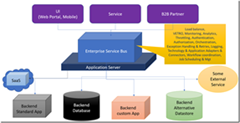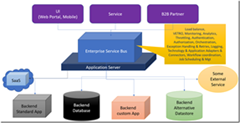Changing views on integration – from Enterprise Service Bus to API Gateway, Serverless and iPaaS by Lucas Jellema
Blog: PaaS Community
If your tool is a hammer, every problem looks like a nail. Many of us have seen situations where this tunnel vision over time took hold. And for many of us involved in integration, this also has happened. In this article I want to briefly draw your attention to changing views regarding integration and regarding the technology for realizing integration. Important triggers for these changing views include cloud, web scale, new type of user interaction, IoT and real time, serverless – and real life experiences with enterprise integration.
From the early 2000s when we started doing enterprise integration in earnest, we talked about the many integration patterns – synchronous and asynchronous, batch and trickle feed and many more – and primarily the ESB pattern. The enterprise service bus, that magic black box with all its connectors that you could simply plug into and that made integration of any system to any other system a simple goal to achieve. And from that somewhat theoretical approach, we then got real ESB products – tools that fulfilled that role of connecting any to any system. Not always as magically as theory had suggested, but still – we most of the times got it to work. Frequently based on XML and SOAP + WS=* based Web Services and with complex products running on massive application servers. In my case the primary technology was Oracle SOA Suite and Oracle Service Bus; comparable products were available from IBM, Microsoft, Tibco, SAP, JBoss, MuleSoft and others. SOA was the architecture style we embraced – with decoupling as the holy grail and important tenets like encapsulation, autonomy, abstraction, statelessness, reusability and the standardized service contract.
And with the integration platform in our hands, almost any data flow seemed a challenge we could nail. The capability to quickly implement a flow from A to B through the ESB product lured us into implementing many different kinds of flows on that platform. Our hammer struck again and again. From “simple UI needs some data elements from a backend database” to “documents arrive on FTP endpoint and have to be stored in document management system” – any arrow between two blocks on a diagram became an ESB subject. Read the complete article here.
For regular information on Oracle PaaS become a member in the SOA & BPM Partner Community for registration please visit www.oracle.com/goto/emea/soa (OPN account required) If you need support with your account please contact the Oracle Partner Business Center.
![]() Blog
Blog ![]() Twitter
Twitter ![]() LinkedIn
LinkedIn ![]() Facebook
Facebook ![]() Wiki
Wiki
Technorati Tags: SOA Community,Oracle SOA,Oracle BPM,OPN,Jürgen Kress
Leave a Comment
You must be logged in to post a comment.









